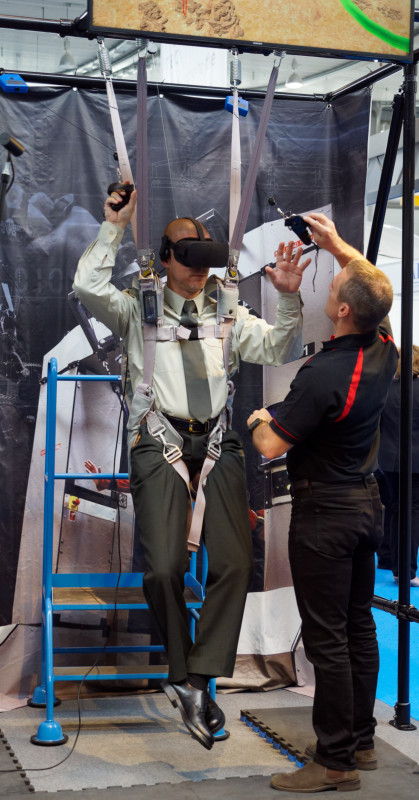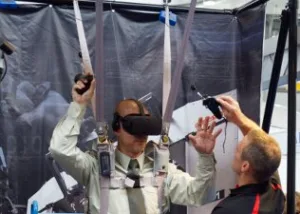Yesterday, I covered the development of several types of 3D displays and today I’m moving on to look at the practical applications.

Here is the link to yesterday’s article (The “Wow” Factor is Just the Beginning (Part 1))
The new generation of 3D displays offers a vast repertoire of applications designed to enhance the performance of anyone working or playing in 3D. The sky’s literally the limit when it comes to what users will be able to do with this exciting new dimension.
Artists/Photographers
3D displays bring models and renderings to life. Artists can create virtual galleries and portfolios that can be shared worldwide. Models and paintings can be textured on 3D displays creating vivid, lifelike presentations.
Engineers/Designers/Architects
Engineers and designers in virtually every field, as well as interior designers and architects, will appreciate the realism and detailed spatial relationships 3D displays provide. Architects can get a “helicopter view” of a building or site to show the overall layout and how elements work together.
In this video the 3D design is viewed with the latest 3D hardware to allow real time ray tracing and highly realistic walkthroughs.
Military
The global drone market is already in the billions of dollars and is expected to grow through the next decade. Military leaders will need 3D technologies as they move drone and robotic technologies onto the front lines. Next-generation 3D monitors allow operators to see topographies and military unit deployments in greater detail–on land, underwater, or in the air. Navy commanders are already investing in unmanned underwater and surface vessels that can sweep for mines, patrol open oceans, and perform other critical functions.
Simulation and Training
Effective 3D display technology provides a realistic simulation experience and practice training for many types of field operations. Heavy machinery operators can train using 3D simulators before they step onto the job site, significantly reducing injury or damage to equipment. Pilots can employ 3D views to train and simulate flying in various weather conditions.
 Our editor took this photo of a parachute simulator at I/Itsec in Germany a couple of years ago. Image:Meko
Our editor took this photo of a parachute simulator at I/Itsec in Germany a couple of years ago. Image:Meko
Gaming
Today’s gamers want the most realistic and lifelike experience when playing. Video games are already a $100b+ market. It’s no surprise that 3D technology will be at the forefront of gaming, driving gameplay to new plateaus of realism and immersion.
Smartphones
With the movie and gaming industries already working on 3D content for cinemas and home, the next logical step is the mobile market. The first products have already begun hitting the market in Asia. While many users might not watch 3D movies on their phones, 3D will be great for on-the-go gaming, and for providing visual cues to spruce up a graphical user interface.
Google Maps
3D display technology brings a whole new dimension to Google Maps. In vehicles, 3D displays create a more intuitive interaction between driver and vehicle to enhance driving safety, especially for 3D navigation. There are already 3D models of 75 city centers across the world, with structures accurately reproduced with physical location, volume, elevation and façade color information.
Check out this video for how to create a fly-through movie using Google Maps and Blender
Surveying
Here, 3D displays can be effectively used to show “as-built” surveys of complex facilities, such as processing plants; deformation monitoring of land or structures; surveying hard-to-reach or hazardous areas; construction planning and progress tracking and modeling. With 3D displays, boundaries and other data can be clearly shown, including hydrographic data.
Medical
Armed with realistic 3D displays, doctors can perform surgeries and can see more detail while they operate. Vivid 3D images can help doctors find hidden tumors and better diagnose cancers. These displays will make the leap from traditional two-dimensional cancer screenings (like mammography) to 3D tomosynthesis, 3D ultrasound, and computerized tomography (CT). With 3D tomosynthesis, doctors can pinpoint the size and location of cancer tumors in dense tissue; they can detect abnormalities earlier and better see small tumors because the images are clearer and have greater contrast.
Drug Research
The applications for drug design and biotechnology using 3D displays can be exponential. One new 3D display has a resolution of 100 million volume pixels or “voxels.” Instead of flat square pixels, voxels also have depth. The complete volumetric nature of the display means no special goggles are required to visualize the image. Such powerful 3D displays are ideal for studying protein structure to alter the way drugs and compounds are discovered. Genomic information is transformed into so-called “structural templates” that are used to discover new drugs.
Depth Sensing
3D depth sensing lets users explore topographies using simple, intuitive gestures and create authentic 3D images on a screen. Users control the experience by tilting, rotating, or making a fist with their hand—a fascinating alternative to touch screens or cumbersome peripheral devices such as joysticks. The new gesture-control technology captures depth information surrounding a user’s movements with unparalleled accuracy and resolution.
3D CAD Modeling
Vivid 3D displays allow designers and modelers to create virtual reality objects with the same properties as an actual physical object—material, weight, size, optical properties, physical properties, etc. This virtual “model” lets designers see how the object will behave in the real world, even before it’s built. Designers can create assemblies of parts to see how they fit together. Or they can test how parts will react to forces applied to them, drop objects to see if they will break, and observe the motion and interaction of moving parts within an assembly. They can also examine how fluids will flow through an assembly and evaluate how assemblies can be manufactured using simulations. Finally, they can render near-perfect images to see how products will look in real life.
Advertising/Marketing Applications
3D displays will dramatically change digital signage, visual merchandizing in stores and advertising globally. Studies have shown that 3D digital displays are 90% better for brand recognition and presentation and can increase revenue by over 25%. They are far better at grabbing and holding a potential customer’s attention than regular 2D displays. The new breed of 3D displays can be placed in malls, cruise ships, resorts, sports bars, ballparks, car dealerships, phone companies, retail shops, and multiple other venues.
Conclusion
The rising demand for 3D displays will usher in a bold and mind-blowing new era of realism in every facet of our lives. It will make what was once fantasy a reality, challenging the imagination of both workers and dreamers. (SP)
Sri Peruvemba is CEO of Marketer International Inc., in California. Peruvemba was previously Chief Marketing Officer for E Ink Holdings, where he played a major role in transforming the startup to a $1B+ global company. With over 30 years of experience in the technology industry, Peruvemba has been an influential advocate in the advancement of electronic hardware technologies. He is an acknowledged expert on sensors, electronic displays, haptics, touch screens, electronic materials and related technologies; and consults, writes, and presents on those subjects globally. Peruvemba has also held senior level positions at Sharp Corp, Cambrios, Novasentis, TFS Inc., Planar Systems, and Suntronic Technology. Based in Silicon Valley, Peruvemba advises high tech firms in the U.S., Canada, and Europe as well as serves on the boards of Omniply, Noctiluca, Summit Wireless, and Visionect. He has BS and MBA degrees and a post-graduate diploma in management. Peruvemba is also a right arm off-spinner for a cricket team he co-founded in Silicon Valley.
This post was moved outside the Display Daily paywall system by DisplayWeek 2021 and does not count towards the two free articles per month. Thanks to them.

